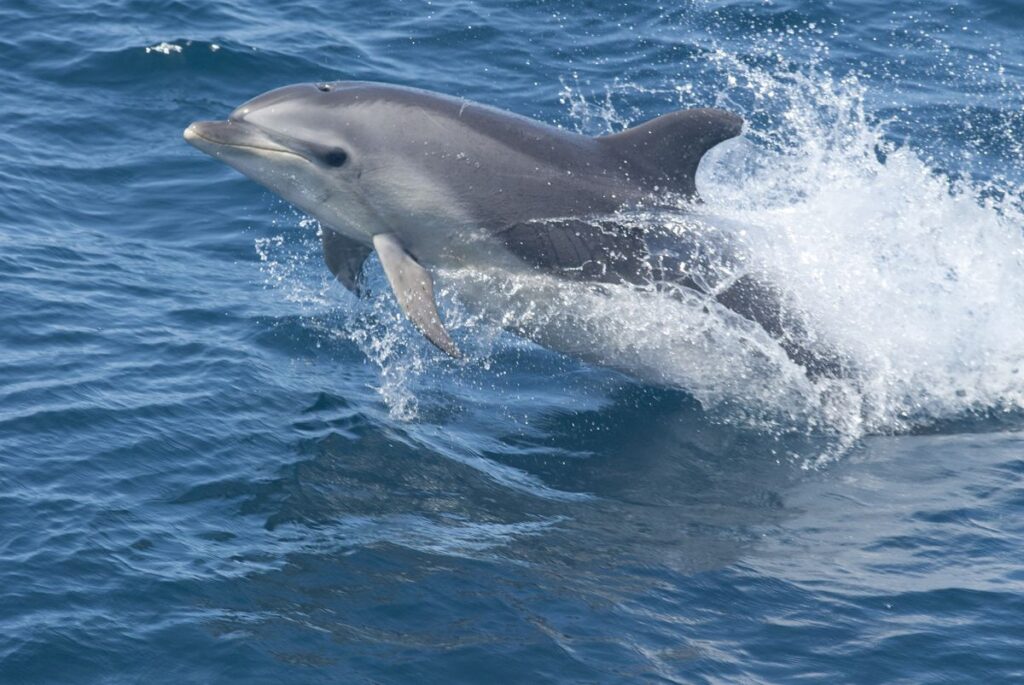Bottlenose dolphins are highly social and typically live in pods.
National Oceanic and Atmospheric Administration
In September 2019, a male bottlenose dolphin began hanging out in Denmark’s Svendborgsund channel. Onlookers thought his behavior was odd, because no other bottlenose dolphins had been reported in that part of the Baltic Sea. Even stranger, the creature was totally alone. Bottlenose dolphins (Tursiops truncatus) are highly social and usually live together in pods. Locals nicknamed him Delle, created a Facebook group and began posting photos whenever they spotted him.
Eventually, Delle (also known as Yoda or No. 1022) caught the attention of marine biologists at the University of Southern Denmark. They lowered a recording device into the water and were flabbergasted to hear Delle making lots of different noises—including many that are typically associated with communication. The dolphin appears to be talking to himself, but researchers don’t know why.
Scientists describe Delle’s “highly unusual” self-talk behavior in a new paper published late last month in the journal Bioacoustics.
Researchers recorded Delle between December 8, 2022, and February 14, 2023. Over the course of 69 days, the dolphin made 10,833 total sounds, including 2,291 whistles, 5,487 low-frequency tonal sounds, 767 percussive sounds and 2,288 “burst-pulses,” or series of clicks made in quick succession.
“I did not expect the dolphin to be vocal,” study co-author Olga Filatova, a biologist at the University of Southern Denmark, tells Forbes. “I expected him to be mostly silent, and I was very surprised to get so many sounds.”
It’s fairly common for individual bottlenose dolphins to head out on their own and explore new territories, Filatova tells Forbes. Scientists think these adventurous individuals might help a species slowly expand its range. And, by mating with other populations, these loners also help maintain genetic diversity within the species.
But many of Delle’s solo noises were “communicative sounds,” which are typically used to “maintain contact and coordinate activities between individuals,” the researchers write in the paper. With no other bottlenose dolphins around to talk to, what was Delle doing?
By the time biologists made their recordings, Delle had been living alone in Svendborgsund channel for more than three years—so, it seems unlikely that he was trying to call out to other dolphins that might be in the vicinity.
Scientists also wondered if Delle could be trying to communicate with a local paddleboarder who often swam with him. But since they heard Delle making noises at night, when humans weren’t present, they ruled out this theory, too.
To add to the confusion, they heard Delle making three distinct “signature whistles,” or unique noises that individual dolphins make to identify themselves, similar to a nametag. “If we hadn’t known that Delle was alone, we might have concluded that a group of at least three dolphins was engaged in various social interactions,” Filatova tells Live Science’s Melissa Hobson.
Scientists still don’t know why Delle was making so many noises. And, because very little research has been conducted on solitary dolphins’ vocalizations, they don’t have a lot of other observations to consider, either.
But they’ve come up with a few theories. Delle might have been talking to himself, just like humans often do when they’re alone. Researchers don’t fully understand why humans talk to themselves, but it may “simply be a byproduct of our intrinsic need for social interaction,” the researchers write in the paper. In other words, as Isaac Schutlz writes for Gizmodo, maybe Delle is just lonely.
Still, the scientists urged against making direct comparisons between dolphins and humans. The fact that we don’t fully understand self-talk in our own species suggests we should be “particularly cautious in drawing conclusions about other species with complex communicative systems,” they write.
Delle might also have been making the noises involuntarily because he was feeling a particular emotion, similar to how humans laugh out loud when reading something funny. If that hypothesis is true, it means scientists might one day be able to use communicative sounds to better understand dolphins’ emotions and behaviors.
Another possibility is that some dolphin sounds could serve additional unknown purposes, beyond just communication, the researchers write.
For now, Delle’s vocalizations remain a mystery. His perplexing solo babble shows just how much scientists still have to learn about bottlenose dolphins.
“We still have some way to go before we fully understand why dolphins make the various sounds in their repertoire,” says Thea Taylor, who serves as managing director at the nonprofit Sussex Dolphin Project in England and was not involved with the research, to Live Science.


